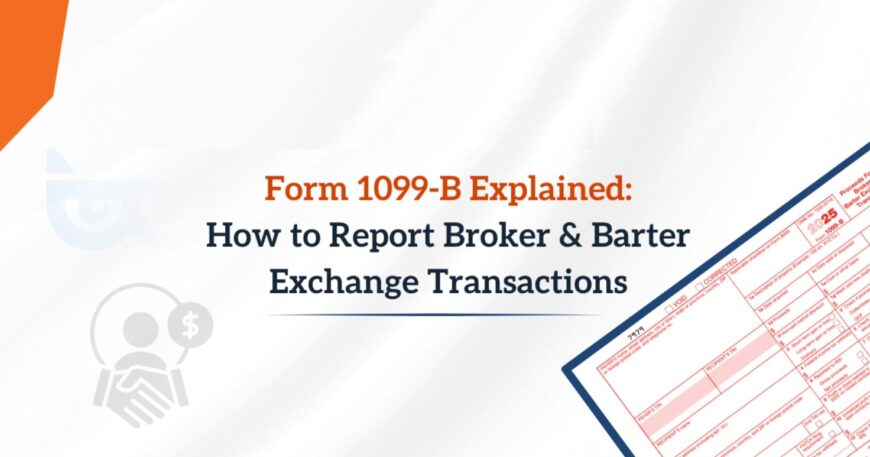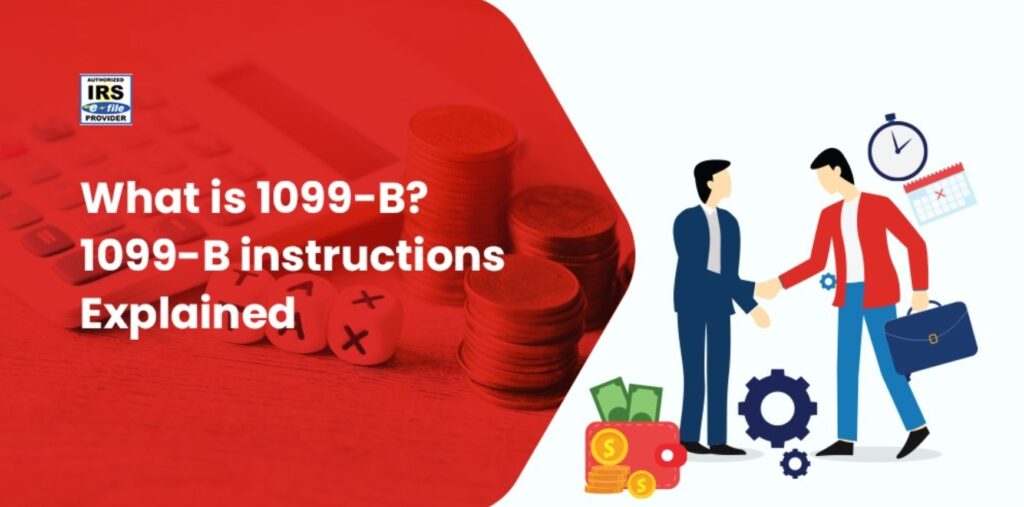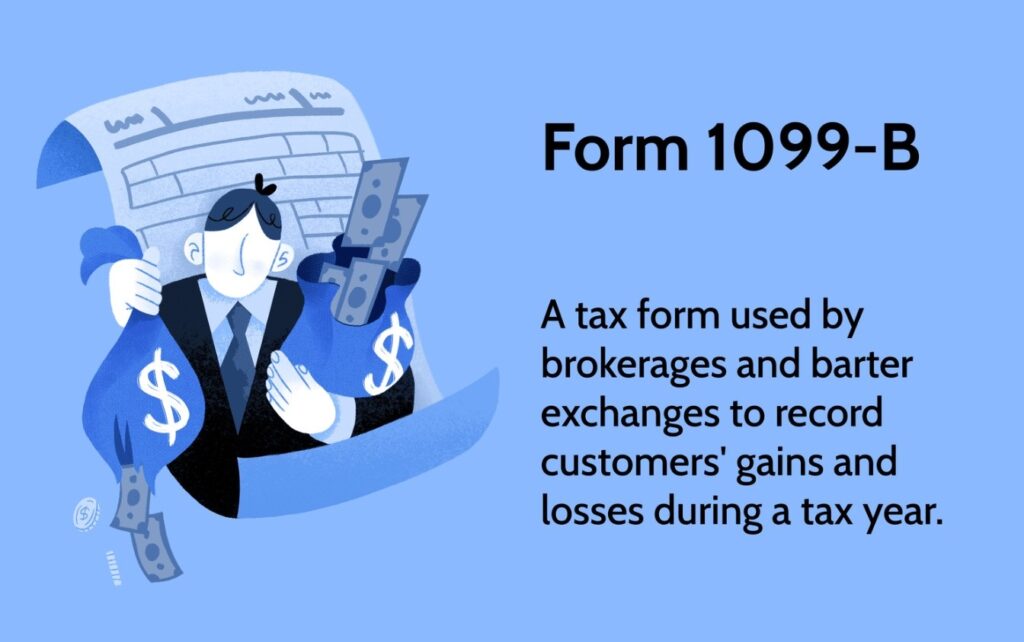What Is a 1099 B Form and Why Do You Need It?
The 1099 B form is a tax document that reports the sale or exchange of securities and certain other property. If you have sold stocks, bonds, or other financial assets, you might receive a 1099 B form from your broker. Understanding how the 1099 B works and its role in taxes is crucial for taxpayers.
In this article, we’ll break down everything you need to know about the 1099 B, including its meaning, purpose, instructions, and how it affects your taxes.
What Is a 1099 B Form Used For?
The 1099 B form is primarily used to report the sale of securities, stocks, bonds, and other forms of investment properties.
If you’ve traded stocks, sold bonds, or made other similar investments, your broker or financial institution will issue a 1099 B form to you by the end of January.
This document helps the IRS track your investment income and capital gains, ensuring that you are taxed correctly.
Here are the most common scenarios where you would use a 1099 B form:
- Selling stocks and bonds
- Selling mutual funds
- Trading options and other securities
- Exchanging property for another asset
For tax purposes, this form reports how much you earned from selling an asset, and it helps you determine the amount of tax you owe on your gains.
What Is a 1099 B Form Meaning?
The 1099 B form meaning revolves around its purpose of reporting financial transactions.
Its primary role is to help you report the capital gains (or losses) from the sale of securities and other property. This form is issued by brokers, mutual fund companies, or other financial institutions to report such transactions.
The 1099 B provides the following key pieces of information:
- Date of transaction
- Description of the asset sold
- Proceeds of the sale
- Cost basis (the original purchase price)
- Capital gains or losses
These details allow you to report your investment income on your tax return accurately.
Key Components of a 1099 B Form
When you receive a 1099 B form, it can seem overwhelming, but it’s essential to know the major components so you can understand the document properly.
Here are the key sections of the 1099 B form:
- 1st Box 1a – Description of Property: The name of the asset you sold, such as a stock or bond.
- 2nd Box 1b – Date of Sale or Exchange: When the transaction occurred.
- 3rd Box 1c – Proceeds: The total amount of money you received from selling the asset.
- 4th Box 1d – Cost or Other Basis: The original cost of the asset, which will help you calculate your gain or loss.
- 5th Box 1e – Gain or Loss: Your capital gain or loss from the sale of the asset.
1099 B Instructions: A Simple Guide
Filing a 1099 B form can seem tricky, but by following the instructions, you can ensure you’re reporting everything correctly to the IRS. Here’s how to use the 1099 B form instructions properly:
- Step 1: Collect your 1099 B forms
After you sell a stock or bond, your broker will send you the 1099 B form. Make sure you receive a copy by the end of January. - Step 2: Understand your proceeds and cost basis
For each sale, the form will list the proceeds (sale amount) and cost basis (original purchase price). This will help you figure out whether you made a gain or loss. - Step 3: Report your capital gains or losses
On your tax return, you’ll need to report your gains or losses. For example, if you sold stocks for more than you paid for them, you’ll have a capital gain. Conversely, if you sold them for less, you’ll report a capital loss. - Step 4: Apply tax rates
The IRS applies different tax rates to short-term and long-term capital gains, so it’s important to categorize each sale appropriately.
By following these steps and referring to the IRS instructions for the 1099 B form, you can file your taxes accurately and avoid penalties.
What Are the Most Common Mistakes With a 1099 B Form?
While filling out a 1099 B form might sound straightforward, people often make mistakes when dealing with this document. Here are some common errors:
- Incorrect cost basis: If the cost basis is not reported accurately, it can lead to incorrect tax calculations.
- Misreporting short-term vs. long-term gains: The tax rate you pay on capital gains depends on whether they are short-term (assets held for one year or less) or long-term (assets held for more than one year).
- Missing trades: Sometimes, brokers might miss a sale or trade. Always double-check your 1099 B form to ensure every transaction is accounted for.
1099 B Form FAQs
Here are some frequently asked questions about the 1099 B form and its usage:
- What happens if I don’t receive a 1099 B form? If you haven’t received your form and believe you should have, contact your broker or financial institution. They are required to provide it.
If you don’t receive it, you may still be required to report the income. - Can I use the 1099 B form to report cryptocurrency gains? Yes, some brokers and exchanges issue 1099 B forms for cryptocurrency transactions. However, if you don’t receive one, you’ll still need to report crypto sales on your tax return.
- What if my 1099 B form contains errors? Contact your broker or financial institution immediately to correct the errors. If the error isn’t fixed, you might need to file an amended return.
How to Avoid Mistakes and Stay Compliant With the 1099 B Form
To ensure you’re staying compliant and minimizing the chances of making errors with your 1099 B form, here are a few tips:
- Double-check the numbers on your form, especially the proceeds and cost basis.
- Use tax software that automatically imports 1099 B data to reduce human error.
- Consult a tax professional if you’re unsure about any part of the form.
Conclusion
Understanding the 1099 B form is vital for anyone involved in trading or investing in stocks, bonds, or other financial assets.
The form reports your capital gains or losses, helping you comply with tax laws and calculate your tax responsibilities accurately.
By following the instructions carefully, you can avoid mistakes and ensure your tax filings are correct.
Remember, you don’t have to navigate the 1099 B form alone. Seek professional help if needed, and take the time to fully understand the form’s details to avoid any costly errors in your tax return.
Why It’s Important to Keep Track of Your 1099 B Forms
The 1099 B form is more than just a piece of paperwork. It’s an essential tool in keeping your finances organized and ensuring that your tax filings are accurate.
Here’s why you should always keep track of your 1099 B form:
- Helps prevent errors on your tax return: If you don’t report the correct capital gains or losses from your 1099 B, the IRS may flag your return for discrepancies, which could lead to audits.
- Prevents overpaying taxes: By accurately reporting your capital gains or losses, you avoid paying more tax than necessary. It also helps you track your investments and determine if they are performing well.
- Future reference: If you ever need to look back on your tax filings or prove ownership of an asset, the 1099 B form serves as an official record of your investment transactions.
Make sure to file and keep copies of all your 1099 B forms for at least three years after filing your taxes, as this will ensure you’re ready in case of an audit or if you need to refer back to them in the future.
How to Handle Multiple 1099 B Forms
If you’ve sold multiple assets throughout the year, you may receive several 1099 B forms from different brokers or financial institutions. Managing multiple forms can feel overwhelming, but here’s how to handle them effectively:
- Organize your forms: Create a separate folder or document to keep track of all your 1099 B forms. This will help you stay organized and prevent missing any transactions when filing your taxes.
- Consolidate the data: If you have several forms, tally the proceeds and cost basis from each one. Many tax preparation software tools allow you to import data directly from your brokers, making this process easier.
- Accurately report each sale: For each 1099 B form, you need to report the individual sale information on your tax return. Ensure that each capital gain or loss is listed correctly. Some software may help you automate this process, but you’ll still need to verify the information.
Additional Tips for Dealing With 1099 B Forms
Handling your 1099 B form doesn’t have to be difficult if you keep these tips in mind:
- Use tax software: Many modern tax software programs can automatically import data from your 1099 B form, making it easier to file your taxes accurately.
- Consult with a tax professional: If you’re unsure about how to handle complicated transactions, a tax professional can ensure you’re filing your taxes correctly and taking advantage of any possible deductions.
- Track your investments regularly: Keep an eye on your investment portfolio throughout the year so that when tax season comes, you already have a good understanding of your gains and losses.
By staying organized and proactive, you can minimize the stress that comes with filing your 1099 B form and ensure your taxes are accurate.
Common Mistakes to Avoid When Filing Your 1099 B Form
While the 1099 B form helps simplify tax reporting, it’s easy to make mistakes if you’re not careful. Here are some common errors to watch out for when filing your 1099 B form:
- Misunderstanding the cost basis: Some investors fail to account for adjustments to the cost basis, such as dividends or corporate actions. This can lead to an overreporting of capital gains.
- Not matching short-term and long-term gains: Misclassifying short-term gains as long-term or vice versa can result in incorrect tax rates being applied. Make sure to double-check the holding period for each asset.
- Forgetting about wash sales: A wash sale occurs when you sell a security at a loss and buy a substantially identical security within 30 days before or after the sale. The IRS requires you to adjust the loss from a wash sale, and brokers report wash sales on your 1099 B.
Conclusion: Understanding Your 1099 B Form
In summary, the 1099 B form plays an important role in ensuring that your tax return is accurate and that you’re not overpaying on your capital gains taxes.
Whether you’re an experienced investor or just starting, understanding the 1099 B form is crucial for staying compliant with the IRS.
By keeping track of your 1099 B forms, reporting your gains and losses correctly, and following the instructions, you’ll avoid common mistakes and ensure that your tax filings are accurate.
Remember, if you ever feel unsure about how to proceed, seeking help from a tax professional is always a good idea. They can guide you through the process and make sure your 1099 B is filed correctly, helping you save both time and money.
What to Do If You Don’t Receive a 1099 B Form?
Sometimes, you might expect to receive a 1099 B form but haven’t received it. This can happen if you forgot to update your contact details with your broker, or if your broker didn’t issue a 1099 B form due to the way the transaction was handled. Here’s what you can do if that happens:
- Contact your broker:
If you’ve had a taxable sale of an asset and didn’t receive the 1099 B form, get in touch with your broker. They should be able to issue the form if it was missed or provide a summary of the transactions that took place. - Check your transaction history:
Sometimes brokers provide transaction history or tax reports that list all your buys and sells. These records can help you calculate the capital gains or losses even if the 1099 B form is missing. - Use other documentation:
If you can’t get the 1099 B form in time, you can rely on your trade confirmations, account statements, or online transaction history to estimate your capital gains or losses for the year. - Report manually:
If the form is not available but you know your gains and losses, you must report them manually on your tax return. You may want to attach a written explanation to your return in case the IRS has questions.
Does the 1099 B Form Apply to Retirement Accounts?
No, typically you won’t receive a 1099 B form for transactions involving retirement accounts such as IRAs or 401(k)s. This is because transactions within these accounts aren’t taxable when they occur, and tax is only due when funds are withdrawn.
However, here are a few things to remember about retirement accounts:
- IRA and 401(k): Investments in tax-deferred accounts do not require a 1099 B form unless you withdraw funds or take a distribution from the account.
- Roth IRA: Similar to IRAs and 401(k)s, transactions within a Roth IRA are not reported on a 1099 B form, but distributions will be taxable under certain circumstances.
If you sell an asset within a retirement account, that transaction is generally tax-deferred. However, once you withdraw funds, you might be required to report the withdrawal as income on your tax return, especially if it’s from a traditional retirement account.
How the 1099 B Form Affects Your Tax Return
When you file your tax return, the 1099-B form plays a key role in helping the IRS determine whether you owe taxes on any gains from investments. Here’s how the form affects your taxes:
- Capital Gains and Losses:
If you sold an asset at a higher price than you purchased it, you have a capital gain, which is taxable. If you sold it at a loss, you have a capital loss.
The 1099-B form provides this data to help you calculate your total capital gains or losses. - Short-Term vs. Long-Term Gains:
The IRS taxes short-term capital gains (assets held for one year or less) at higher ordinary income tax rates.
Long-term capital gains (assets held for more than a year) are taxed at a lower rate, making it essential to distinguish between the two on your 1099-B form. - Offsetting Gains with Losses (Tax-Loss Harvesting):
If you have losses from some of your investments, you can use those losses to offset your gains. This is known as tax-loss harvesting and can reduce the amount of taxes you owe.
If your losses exceed your gains, you can use the excess loss to offset up to $3,000 of other types of income.
Important Tax Tips for Filing a 1099 B Form
To make the filing process smoother, consider these tax tips when dealing with your 1099-B form:
- Know the holding period:
Always check the holding period of the securities you sold. This is crucial to ensure that you classify the gain as short-term or long-term, which determines the tax rate applied to your profits. - Report all transactions:
If you sold multiple assets, be sure to report each transaction. Even if you had a net loss, you are still required to report all sales to avoid penalties. - Consider consulting a professional:
Tax rules surrounding investment income can be complicated, especially if you’re new to filing taxes for investments. Consulting a tax professional can help ensure your 1099-B form is filled out properly and that you’re maximizing your deductions and credits. - Use tax software:
If you’re filing your taxes yourself, using tax software that can automatically import 1099 B forms from your broker is a great way to reduce errors and make the filing process more efficient.
Conclusion: Mastering Your 1099 B Form for Tax Success
The 1099 B form may seem complicated at first, but once you understand its purpose and how it works, it becomes much easier to handle.
By knowing what it is, how to read it, and how to use it to report your capital gains and losses, you’re setting yourself up for tax success.
Remember, proper documentation is the key to accurate reporting. Stay organized, keep track of all your 1099 B forms, and use tax software or consult with professionals if you need help. The right approach to managing your 1099-B form can save you time, reduce errors, and help you pay the correct amount of taxes.







